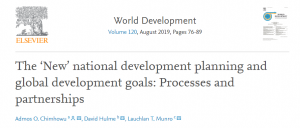
New open access research published in World Development
World Development have published a new open access article by Admos Chimhowu, David Hulme and Lauchlan Munro, based on the key findings from National Plannning in the Global South research project.
The ‘New’ national development planning and global development goals: Processes and partnerships is based on an analysis of 107 national development plans, and draws insights from 10 case study countries. The paper analyses current national development planning and identifies the types and content of the plans, and their implications for the sustainable development agenda.
It finds that:
- Over 130 countries have produced national development plans to show their priorities for achieving SDGs.
- Many of the plans are a product of national consensus processes although some are produced mainly technocratic elites.
- The five year (medium term) plan is the most popular although some countries have longer term visions documents.
- National Planning Commissions are back and play a lead role although Economic Ministries still dominate the process.
- A majority of national plans lack financing strategies a factor that can affect implementation and achievement of SDGs.
More than 80% of the global population now lives in a country with a national development plan of one form or another. This is a stunning recovery of a practice that had been discredited in the 1980s and 1990s as a relic of directed economies and state-led development.
The new generation of national plans has been neglected by academic researchers and merits much greater examination, especially to understand the ways in which their implementation can enhance the achievement of the SDGs.
Download the full, open access paper.
Watch Admos Chimhowu discuss the key findings:





0 Comments